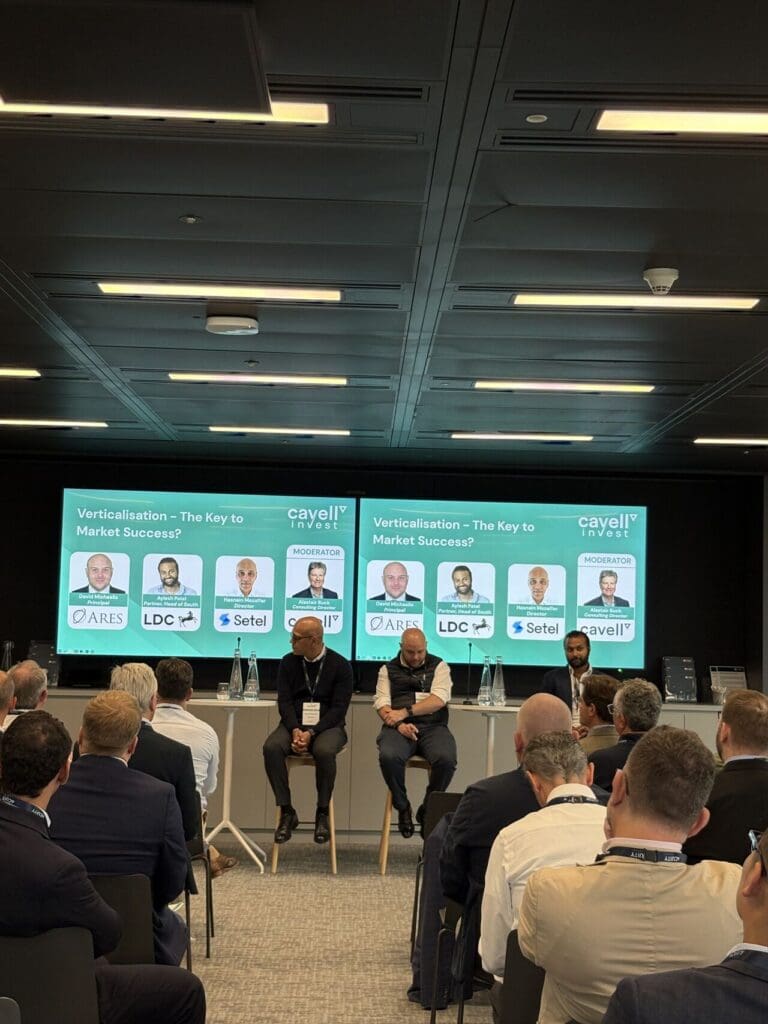Cavell Invest: Is the M&A Scene Hotting up Again?
With geopolitical tensions and economic volatility creating a cautious investment climate, Cavell Invest brought together industry experts, investors and technology leaders seeking clarity on the future of M&A in the technology and communications sector.
The Trump administration’s early turbulence, combined with broader global instability, has dampened deal flow compared just a few years after the 2021 boom.
However, beneath the surface caution, a cautious optimism has emerged. Investors remain active, though with heightened scrutiny and more rigorous due diligence processes. As one speaker noted, investment committees now demand unprecedented levels of detail before proceeding with acquisitions. This more disciplined approach reflects a market that hasn’t disappeared but has evolved to manage risk in uncertain times.
Is M&A Awakening?
The Cavell event opened with Greg Leyshon from Osborne Clarke providing context on the current M&A environment. He noted that, over recent months, much activity has slowed down. However, things appear to be improving. After the initial chaos of the Trump administration and various geopolitical issues, the market is beginning to stabilise.
There seems to be renewed appetite from businesses, investors and debt providers to become more active in the market, he said, specifically for continued consolidation in the UK and in low-cloud-penetrated markets like Germany and France.
While not predicting a boom like 2021, he suggested the market could bounce back if geopolitical conditions remain relatively calm.
Driving Value with the Intelligent Workplace
Cavell’s Dom Black presented research on the intelligent workplace and evolving market priorities, which are essential to driving service provider value.
He cited Cavell’s enterprise research which surveyed 2,000 IT buyers and unearthed several key drives informing buyer habits.
There is significant motivation to enhance customer service through new solutions, particularly in the SMB sector.
When speaking with enterprise customers and service providers, these findings align with market drivers.
Some 77% of businesses seek better customer service, and MSPs confirm that contact centres constitute a growing part of their portfolio. Vendors are incorporating more contact centre features into their offerings.
Elsewhere, across all business sizes, AI is driving efficiency and productivity. The third notable trend involves enhancing compliance and security.
AI has become a focal point, particularly regarding internal data privacy. Companies are seeking MSP partners to help deliver security solutions and provide guidance, as many lack the necessary skills.
From a cybersecurity standpoint, many businesses want to purchase security alongside their telephony and collaboration solutions. Though security remains a small part of MSP portfolios, it’s undoubtedly growing in importance for both enterprises and channel partners.
All these trends are evolving the market from siloed technologies, where vendors addressed single applications and MSPs focused on specific solutions, to a holistic intelligent workplace.
Integration has become crucial, extending beyond merely connecting contact centres with CRM systems. There’s growing emphasis on vertical applications, all wrapped within a security and compliance layer. This creates challenges for MSPs as they determine whether to focus on being a niche provider or offer a comprehensive suite.
While specialists still exist, enterprises increasingly seek integrated services and prefer dealing with a single supplier.
Verticalisation to Differentiate
The verticalisation panel featured Aylesh Patel from private equity firm LDC, David Michaelis from alternative investment manager Ares Management and Hasnain Mozaffar from Setel, a communications provider focused on shipping companies.
When asked about the importance of verticalisation in acquisitions, the noted it was increasingly significant. In an increasingly fragmented market, verticalisation helps differentiate businesses, establishes a right to win, and drives organic growth – all factors that ultimately drive investment.
The concept of tiering in verticalisation was highlighted as important. Diversified businesses like Kerv were positioned in tiers 1/2.
The panel also emphasised that vertical specialisation in regulated industries is particularly important for delivering higher-quality service. Companies with a vertical focus typically have strong products and software in their chosen verticals.
Once a vertical specialism has been established, new business often comes through company referrals rather than organic outreach, while word-of-mouth leads to better quality business and improved sales.
Regarding investment KPIs, the panel said that verticalisation is featuring more frequently in equity stories. It affects margin, organic growth, and customer retention, with vertical assets typically growing faster due to better competitive positioning.
Mozaffar explained that operating in the shipping sector requires understanding the commercial and regulatory environment. This can involve unusual arrangements, such as having an office in the middle of the Indian Ocean. Because of Setel’s expertise, customers now approach Setel with their technology requirements, including AI questions.
When discussing whether it’s easier to be vertical or broader, Mozaffar noted it depends on the market. In shipping, building trust requires having people with the right background, making them more difficult to recruit. Once established, however, it becomes easier. Having shipping experts in the organisation informs product strategy – an important consideration for investors. This creates a high barrier to entry, making the right people and skills vital.
The panel emphasised that people retain value over AI.
Discussing challenges, Mozaffar observed that while shipping might seem niche, 90% of global trade moves through shipping. It offers a narrow vertical but significant global reach, though potential trade volatility exists.
Other challenges include sector volatility and the need to consider pivoting into adjacent products (e.g., expanding from schools to universities). The narrower focus means working with a smaller target market, so breaking in and becoming successful presents a challenging starting position.

Broad or specialist (or both)?
The specialisation panel included Andrew Reilly (Akixi), Andrew Belshaw (Gamma), and Joel Chimoindes (Nuvias UC). They discussed whether specialisation or a broad product portfolio would drive more value.
When asked about Gamma’s positioning, Belshaw described them as specialists in a broad area – communications. He explained they need breadth, so businesses of any size can approach them with communication problems. Their portfolio continues to expand.
Nuvias CEO Chimoindes said the distributor has recently repositioned its offering to channel partners to better represent its core offerings: hardware, software and services. This, he said, gives the firm a better chance to display its specialisms and increase cross-selling opportunities with existing partners.
Belshaw said that Gamma is taking steps to become even broader, with security an area that is increasingly considered, especially around SASE,
However, they encounter difficulties bringing security through the channel to SMBs, as channel partners often lack the capability to sell security effectively because a more consultative approach is needed.
The panel identified a productisation issue for channel partners, as many rely on distribution and vendors. When asked which areas provide the most value, Nuvias mentioned products and services, particularly around AI. Chimoindes said Nuvias is developing services to help mid-market and smaller resellers capitalise on this technology.
Gamma, meanwhile, is redefining relationships with channel partners. It’s working on a deal to help partners with first-line support where needed, re-engineering these relationships to help them sell more products more easily and revamping its portal to make these products easier to consume.
DNA for Success
Cavell Managing Director Matt Townend shared observations on what creates successful investment and sale outcomes in 2025. Despite overall market decline, Cavell has seen more M&A inquiries in the past four weeks than in the previous three months.
There’s a significant focus on preparation for a sale.
Townend said investment committees have become extremely cautious, Townend described a current project where an investment committee wanting a detailed analysis of an MSP’s strategy, down to the revenue split per each vendor partner. Due diligence is more rigorous than ever before but, paradoxically, equity stories need to be simpler than ever to capture investors’ imaginations.
Security presents both challenges and opportunities, as enterprises prioritise security and compliance while many communications providers are lacking in this areas,
Recent Cavell research found enterprises are willing to pay a premium for security products and services, but these do not feature prominently in many provider portfolios. This extends beyond traditional firewalls and network security, with a growing focus on identity management.
Townend observed increased demand for specialist advice over point-product sales, with companies seeking expertise in specific areas due to the level of detail now required.
The channel is undergoing significant change. Previously defined by what they bought, channel partners are now defined by their skills, role, and how they service customers. New routes to market and ecosystems provide interesting opportunities. Enterprise app stores from the likes of Salesforce and Amazon Web Services are gaining traction, while companies like Pax8 are disrupting traditional distribution with independent marketplaces.
Meanwhile, due diligence teams must answer key questions about topics like AI and Microsoft. Townend mentioned a deal Cavell recently worked on in the US that collapsed because the selling company could not articulate its approach to Microsoft being a threat or an opportunity. The potential answer could have been positive, suggesting opportunities to service new customer types globally, particularly in the SME sector.
Overall, M&A stories must be less complex, he said. Townend’s current work primarily involves helping businesses prepare, develop their equity story, and simplify their narrative.
Organic growth is now imperative, with businesses now having to demonstrate some organic growth rather than relying solely on the buy-and-build strategies that were particularly common in the UK channel prior to the pandemic. Go-to-market strategies receive close attention, and due diligence has become more detailed and specific.
Townend added that recent due diligence work at Cavell has focused on CX businesses. Interest continues in companies selling solutions in voice, IVR, and CX areas, with deals likely to close soon including highly verticalised businesses.
Conclusion
The Cavell event demonstrated that demand for M&A activity exists, albeit in a cautious fashion. The general sentiment suggests that while the market won’t reach the boom levels of 2021, there’s renewed appetite for deals if geopolitical conditions remain stable.
Investment committees are applying unprecedented scrutiny to potential acquisitions. They seek clear equity stories, proven organic growth, strong customer retention, and well-developed specialisation strategies.
Verticalisation and specialisation appear to drive higher valuations by creating differentiation, improving competitive positioning, and enabling more targeted go-to-market approaches. Companies with expert knowledge in specific sectors or technology domains maintain an advantage.
The intelligent workplace continues to evolve, with AI, security, and integration serving as key drivers. However, human expertise remains crucial, particularly in vertical markets where understanding specific industry needs creates lasting value.
In summary, M&A demand exists but operates within a more disciplined framework than in previous years. Those businesses with clear specialisation, proven growth models, and strong retention metrics will attract the most interest in this cautious but active market.
